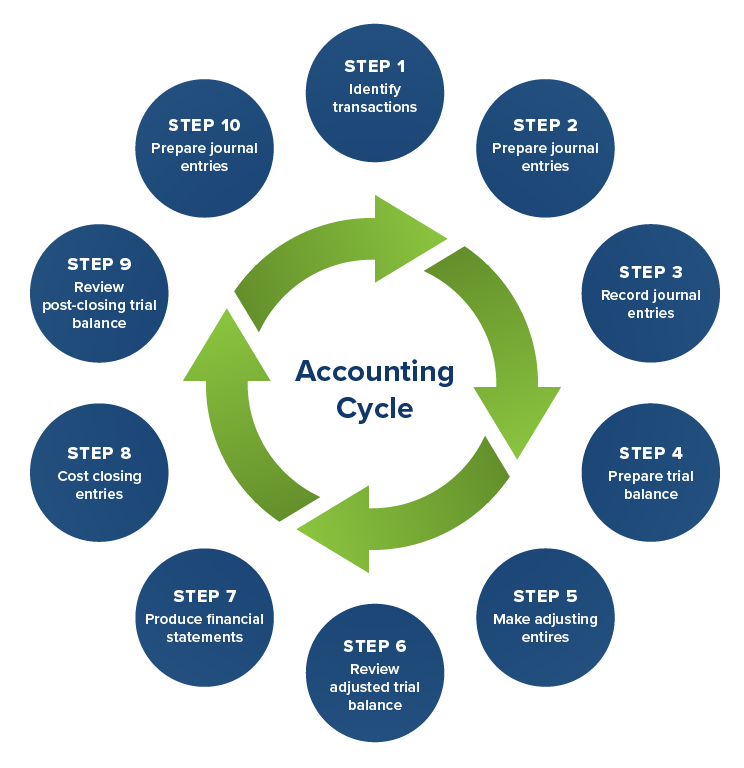
Blog -




Accounting
What Are the 10 Steps in the Accounting Cycle?
If you work for a business in the accounting department, you’ll quickly become familiar with the accounting cycle. The goal is to create digestible and informative financial statements, which are essential because they empower business owners by understanding their financial position and their strengths and weaknesses.
Accountants prepare financial statements for a business by following a chain of activities that allows a company to track transactions and collate information during a specific accounting period.
You may already be familiar with this process, but let’s dive deeper to understand why it’s important.
What Is the Accounting Cycle?
According to Investopedia, the accounting cycle is a collective process of identifying, analyzing, and recording the accounting events of a company.
You’ll achieve this by following a structured 10-step process that begins with a transaction and ends with financial statements letting a company plan expenses, secure loans, or even sell the business. Before we jump into the steps, let’s discuss why they’re essential.
First, each step in the accounting cycle is dependent on the last. In fact, you must complete each step before moving on to the next. Skipping one could create inaccurate data and flaws within the entire financial reporting process, resulting in the business making ill-advised decisions.
There are three primary reasons the accounting cycle is essential.
- Compliance
- Internal analysis
- Efficiency
Compliance – An accounting cycle keeps businesses in compliance with accounting rules and tax laws, ensuring accuracy and uniformity. If a company sought investors or potential buyers, following the accounting process would keep the market fair for competition while making accurate information readily available.
Internal analysis – Using the accounting cycle gives businesses the information to make critical financial decisions. The process organizes each aspect of a company’s financial activity to evaluate trends that help set goals. Without knowing its assets, liabilities, and cash reserves, the business can’t grow.
Efficiency – When accountants follow the accounting cycle, it functions as a checklist. This reduces errors, ensures each step is completed, and streamlines the workload. No one has to guess what comes next. Additionally, the cycle perpetuates itself. The end steps prepare the accounting team to perform the same functions again in the next accounting period.
What Are the 10 Steps in the Accounting Cycle?

The number of steps in an accounting cycle depends on the business and its needs; however, these ten are a good baseline for most companies.
Let’s look at each step in more detail.
Step 1: Identify financial transactions
The first step in the process is to identify all financial business transactions. You’ll gather:
- Receipts
- Invoices
- Bank statements
As well as any other source documents of basic transactional information to be translated into valuable financial data.
Step 2: Prepare a journal entry
In this step, you will break down the purpose of each transaction by listing the
- Date
- Amount
- Location
The details help define how the information gets recorded in journal entries.
Step 3: Record journal entries in the general ledger
Once you’ve gathered and finished analyzing transactions, you’ll use the general ledger to enter the data.
The general ledger (G/L) is an extensive, numbered account list that lays out all of the business’s transactions. For our purposes, the G/L accounts are buckets for your transactions, such as
- Cost of Goods Sold (COGS)
- Professional Services Expense
- Cash Account
- Accounts Payable
- Receivables.
The G/L includes journal entries that list the business’s financial transactions in chronological order. You should be following the accounting principles of double-entry accounting, sometimes called double-entry bookkeeping. This means journal entries must be made in two parts: A debit and a credit.
Once the transactions you gathered in step one are converted to debits and credits, you can begin recording transactions in the G/L. This is usually done as transactions happen to keep the information accurate and up-to-date for most businesses. Still, for small companies that don’t have a large volume of transactions, this can be achieved once a period.
Step 4: Prepare and review the trial balance
Once all the journal entries are entered, your next step is to create an unadjusted trial balance. This step simply adds up the totals from each account for both debit and credit balances. They should be equal. If they’re not, go back and double-check each journal entry.
This is also where you’ll analyze G/L accounts for reasonableness to determine what adjusting journal entries are needed.
Step 5: Make adjusting journal entries
Your next step is to make any adjusting journal entries necessary so your financial statements include relevant information for your working period.
There are three types of adjusting entries: Accruals, tax adjustments, and missing transaction adjustments.
Accruals refer to expenses or revenues that you’ve incurred or earned but haven’t paid or received. (e.g., an invoice you’re still waiting for a customer to pay or the bill from your supplier that hasn’t been paid yet). It makes sure your financial statements take future payments and expenses into account.
Tax adjustments account for your tax deductions, such as depreciation. They typically happen once a year, and the business’s CPA can guide you through these if you’re not familiar with tax-related entries.
Missing transaction adjustments account for any financial transactions you may have forgotten about or missed in step one. This might include the office manager giving you a supplies receipt late or petty cash expenditures.
Adjusting journal entries are tracked on a worksheet for easy reference in case there are any questions.
Step 6: Review the adjusted trial balance
After entering all of your adjustments, the next step is to prepare an adjusted trial balance. Just as you did in step four, you’ll add up the debit and credit columns of all your journal entries, including the adjustments you made. As before, your G/L’s debits and credits should equal.
Step 7: Produce financial statements
Next, you’ll prepare the financial statements. There are three primary financial statements most companies create:
- Balance sheet
- Income statement
- Statement of cash flow
You prepare the balance sheet, which comprises assets, liabilities, and owner’s equity information. Next, the income statement uses information from the adjusted trial balance’s revenue and expense account sections. The cash flow statement shows how cash enters and leaves the business and how non-cash entries like depreciation affect net income.
Step 8: Post your closing journal entries
After completing the financial statements at the end of the accounting period, the next step is to record closing entries to get the books ready for the next period. This step transfers account balances from temporary accounts to permanent accounts.
Step 9: Review post-closing trial balance
Because debits and credits must always balance, you must prepare a closing trial balance once you’ve closed out the temporary accounts. Add up the totals for both the debit and credit columns of the general ledger to ensure they balance.
Step 10: Record reversing entries (if necessary)
Reversing entries are journal entries made to the G/L at the beginning of a new accounting period that cancels out adjusting journal entries made at the end of the previous accounting period.
This is done to take care of any accruals or prepayments that occurred between the two cycles, so it may not be a necessary step for each business.
The steps of the accounting cycle may seem complicated when viewed as a whole. But the payoff for following it is actionable financial information for the business.


